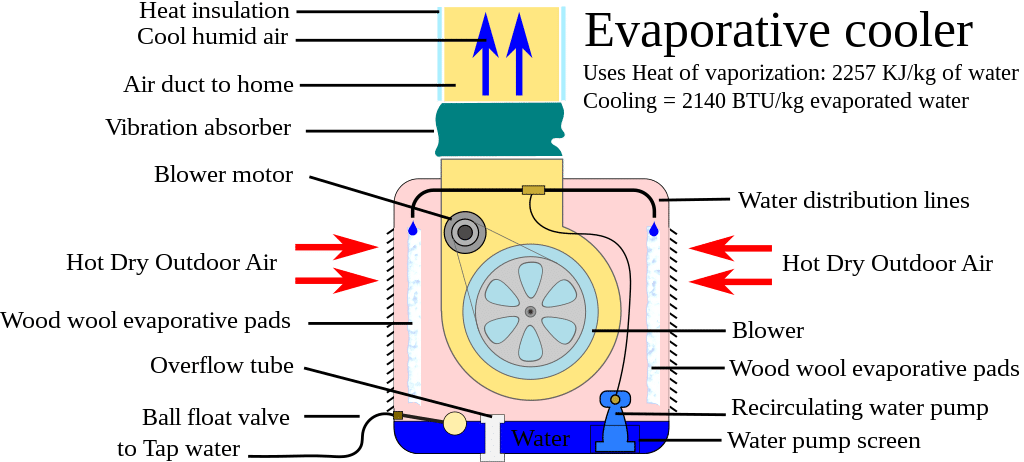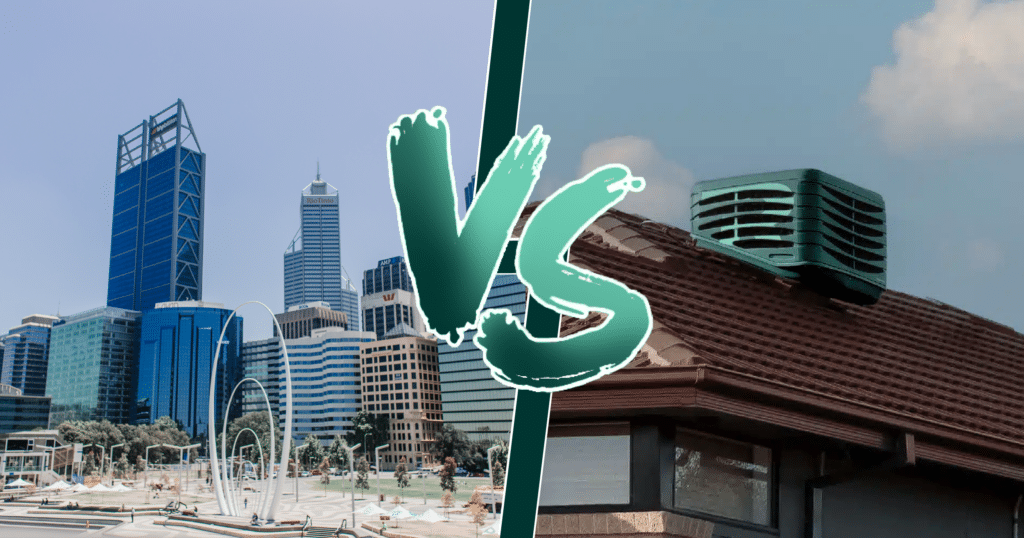As your local evaporative air conditioner specialists, there’s one question we’ve been asked time and time again: does evaporative cooling actually work here in Perth? Keeping our families cool during the scorching Perth summers is something we’re passionate about, so we thought we’d go ahead and crunch the numbers and put that Perth catchphrase – “at least it’s a dry heat!” – to the test.
Looking online, nobody can seem to come to a real conclusion, and asking your friends and family often results in anecdotal arguments and no clear answer. This is further complicated by evaporative air conditioners not having as vigorous energy standards as other refrigerated systems – but that doesn’t mean the research hasn’t been done. Join us as we walk through the processes behind evaporative aircon effectiveness by collating the research and crunching the numbers for Perth and surrounds, so you don’t have to.
Measuring Perth’s humidity and evaporation effectiveness
Humidity itself is measured using something called a ‘sling psychrometer’, which measures the difference between two mercury thermometers: one exposed directly to the ambient air (the ‘dry bulb’ temperature) and the other wrapped in a saturated wick (the ‘wet bulb’ temperature). The higher the humidity in the air, the less water that can evaporate and remove heat energy from the wet bulb and, in turn, the lower the difference between wet and dry bulb temperatures. By calculating the difference between the maximum and minimum temperatures possible for the wet bulb to achieve (i.e., 0% humidity, where the wet bulb temperature is the lowest it can be if all the water could be evaporated into the air, and vice versa for 100% humidity) gives us the relative humidity – the figure you hear on the weather channel.

Because evaporative air conditioners rely on the evaporation of water into the air to function, they tend to be limited by the climate in the same way the wet bulb’s temperature is limited by the surrounding air’s humidity and temperature. Luckily for us, the Bureau of Meteorology tracks both dry bulb temperature (how hot it is) and wet bulb temperature (how humid it is) for Perth and WA every single day. By taking this data and finding the points where an evaporative air conditioner can cool us down to a comfortable indoor temperature of 24°C or below, we can plot out the most effective humidity and temperature band for evaporative cooling.
Of course, like many things evaporative air conditioners can’t quite reach 100% evaporation efficiency. According to the National Evaporative Air-Conditioning Equipment Standard (AS/NZS 2913-2000), the evaporation efficiency (how close it can get the air to the wet bulb temperature) tends to be around 70% on the lower end of models to 85% on average and up to 95% for your higher end models. For the everyday HVAC enthusiasts out there, an easy rule of thumb we can use is to add 3-4°C to the wet bulb temperature to find the actual temperature reachable by evaporative cooling.
Crunching the numbers: evaporative cooling effectiveness in Perth and WA
Given all the above information, we can come up with a table that shows us the ideal temperature and humidity range for evaporative air conditioning use. Plotting the relative humidity on our left column and the outside temperature along the top, we can find the indoor temperature that evaporative air conditioning can reach on a given summer’s day:
| Relative Humidity | 24°C | 27°C | 29°C | 32°C | 35°C | 38°C | 41°C | 43°C | 46°C |
|---|---|---|---|---|---|---|---|---|---|
| 10% RH | 14 | 16 | 17 | 19 | 21 | 23 | 25 | 27 | 28 |
| 20% RH | 15 | 17 | 19 | 21 | 23 | 26 | 27 | 29 | 32 |
| 30% RH | 17 | 19 | 21 | 23 | 26 | 28 | 30 | 32 | 34 |
| 40% RH | 18 | 20 | 22 | 25 | 27 | 29 | 32 | ||
| 50% RH | 19 | 22 | 23 | 26 | 29 | 31 | |||
| 60% RH | 20 | 23 | 24 | 28 | 31 | ||||
| 70% RH | 21 | 24 | 26 | 29 | |||||
| 80% RH | 22 | 25 |
Taking the Bureau of Meteorology 2022 weather observation data, we can then map the Perth weather conditions to the above table, which gives us the temperature we can reliably expect our evaporative air conditioners to cool us down to on the average summer day in Perth:
Average indoor temperatures using an evaporative air conditioner – Perth
| Month (2022) | 3pm Mean Relative Humidity (%) | 3pm Mean Temperature (°C) | Indoor Temperature with Evaporative Cooling (°C) |
|---|---|---|---|
| January | 33% | 32 | 23 |
| February | 32% | 33 | 23 |
| March | 42% | 29 | 22 |
| April | 45% | 25 | 18 |
| May | 51% | 21 | 18 |
| June | 58% | 19 | <18 |
| July | 58% | 18 | <17 |
| August | 57% | 17 | <17 |
| September | 52% | 20 | <17 |
| October | 46% | 20 | <17 |
| November | 45% | 24 | 18 |
| December | 36% | 28 | 22 |
Assumes 85% evaporative efficiency and air flow of recommended 30 air changes per hour.
Of course, we know we have those days where the air feels thick while the summer sun does nothing to clear it up. According to the 2022 BoM daily weather data for Perth, we ran the numbers and found a total of ten days where the 3pm temperature and humidity meant that the indoor temperature reached by evaporative cooling is above 24°C. The good news is that, while we might not be shivering inside during these humid outliers, the indoor temperature is still cooled to the recommended comfortable temperature setting of 25°-27°C indoors.
Why is my evaporative aircon not working as well as it should?
Of course, every house and aircon installation is different, and there’s a few things that will impact the effectiveness of your evaporative air conditioner:
1. You have bad or poorly installed insulation and ducting
Like other air conditioners, evaporative air conditioning tends to work best in well-insulated homes that can insulate the cooler air inside on a hot summer’s day. If your insulation isn’t up to scratch or the ducting was installed and sealed poorly, the cool air can’t reach you as easily, leading to inefficient cooling and sweaty nights.
2. You live in a more tropical climate zone than Perth

For those not in Perth, your climate zone will differ slightly to those living in Perth Metro (check out the handy map of climate zones from the National Construction Code design reference to see what climate you live in). The good news is, with so much of WA’s climate being dry and arid, if you live in one of the hotter and less humid areas on the map, a properly installed evap aircon will still be ideal for you!
3. Your evaporative cooler is due for a service
A system that hasn’t been properly maintained will not work as effectively as a well-maintained one, dropping the efficiency to as little as 50%. Since evaporative aircons use both water and mechanical parts, it’s important to keep it well-serviced and maintained by your local aircon servicer, which we recommend doing once a year.
If you’re still having issues with your evap aircon, check out our handy guide on energy-saving air conditioner hacks, or reach out to one of our friendly evaporative experts here at Ritz Plumbing & Electrical for everything else evaporative cooling today. Chat to one of our friendly representatives now by calling 13 74 89 or send an enquiry using our easy online contact form and we’ll get back to you as soon as we can!



